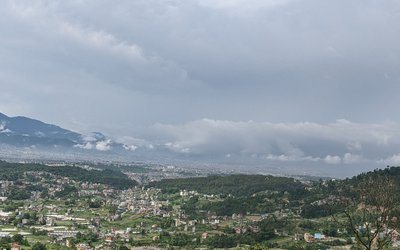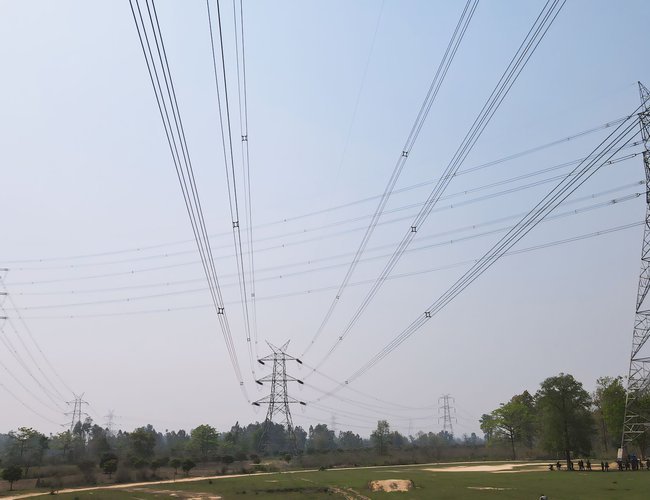
According to the Bangladesh Economic Review 2023 Report, the total installed capacity of Bangladesh was 26,700 MW,as of January 2023, out of which the maximum generation is around 15,000 MW. If we turn to earlier Power System Master Plan (PSMP) 2016 of Bangladesh, it is found to have outlined the generation target of 40,000 MW by 2030 and 60,000 MW by 2041. When we compare Nepal and Bangladesh in terms of per capita electricity consumption, the figures do not show a sharp contrast since Nepal looms at 380 kilowatt-hours and Bangladesh stands at 464 kilowatt-hours. It demonstrates that the two countries, despite a huge difference between installed capacities or power demands, are almost on the same page as both of them represent to be energy-poor countries since the per capita consumption of modern energy is less than 1,000 kWh. While saying so, this is also important to unfold that Nepal’s power sector is hundred percent renewable-based, mostly driven by hydropower, whereas Bangladesh’s electricity generation is dominated by natural gas and furnace oil. Out of 15,000 MW generation, gas-fired plants contribute 6,000 MW in Bangladesh. The reality of domestic fuel shortage is so harsh that even for this much power generation, the import of gas corresponding to 1,000 MW of power is unavoidable for the country.
So far as Bangladesh’s renewable commitment is concerned, the Prime Minister of Bangladeshannounced during the COP26 in Glasgow, UK, in November 2021 that they hoped to have 40% of their energy from renewable sources by 2041.
It is also learnt that Bangladesh, besides the global scenario of hard economic times, is chiefly undergoing two types of difficulties in power sector: dollar crisis to import primary energy for power generation and transmission constrains to import more power from the neighboring countries.
The Latest Master Plan
Bangladesh has formulated Integrated Energy and Power Master Plan (IEPMP) 2023 as a long-term plan up to 2050 by incorporating the concept of “S plus 3E” representing Safety, Energy Security, Economic Efficiency and Environment as the central pillars of planning. The Plan also comprised the objective of use of imported hydropower and solar power from India, Nepal and Bhutan. The Plan envisaged to import 15,700 MW of renewable energy (14%) of the total fuel mix in the timeframe of 2050 and the import proportion represents to be the third highest after gas and Liquified Natural Gas (LNG) at the first place and the wind power at the second place. It can be concluded that cross border transmission facilities between Bangladesh and the neighboring countries should be developed aggressively and expeditiously to turn the objective of the Master Plan into reality.
In addition to seasonal and daily complementarity between Nepal and Bangladesh, there is geographical benefit for Bangladesh to import electricity from Nepal and Bhutan since this import is expected to avoid the situation of transmitting a huge quantum of power to the northern region from the south where large power plants are considered in its coastal areas. The latest Master Plan has also mentioned that there will be 12 connection points with the neighboring countries enabling the power import exceeding 10 GW accounting for 14% to 20% of the total demand of between 50 GW and 70 GW projected for the 2041 timeline. The optimal interconnection points for the cross-border power trading between Bangladesh and the neighboring countries should be explored though techno-economic studies including system security studies.
Power Import/Export Agenda at Centre
Bangladesh and India have discussed about the tripartite investment of Bangladesh, India and Bhutan in the hydropower projects in Bhutan and transfer the power to Bangladesh via the Indian territory in the 21st Joint Working Group/Joint steering Committee (JWG/JSC) Meeting held on 3-4 May, 2023. Since the eastern and the north-eastern regions of India have already been connected to Bhutan through power transmission and further interconnections between the two countries may be explored to bring more Bhutanese hydropower to India and further supply it to Bangladesh since Bhutan is land-bordered to India as the case of Nepal to reach Bangladesh through India alone. Bornagar Substation in Assam (North-Easter Region, India) and Katihar Substation in Bihar (Eastern Region, India) may be connected to Parbotipur/Barapukaria (Parbatipur- about 6 km north of Barapukaria) through Bornagar-Parbotipur-Katihar 765 kV transmission line to be initially charged at 400 kV which is being discussed at Bangladesh-India JWG/JSC meeting as a main agenda item.
In addition to the request made by the Bangladesh side for the import of power from Nepal and Bhutan, the implementation of the proposed high-capacity 765 kV linethrough a suitably structured joint venture for a Special Purpose Vehicle was also emphasized in the India-Bangladesh Joint Statement issued during the state visit of H. E. Prime Minister of Bangladesh to India during September 5-8, 2022. This 765 kV line can be useful to supply power not only from India and Bhutanto Bangladesh, but also from the Eastern region to the north-Eastern region within India itself. Further, Bangladesh H. E. Prime Minister, Sheikh Hasina, reiterated her country’s willingness to import hydropower from Bhutan through India to the Bhutanese H. E. Prime Minister, Dasho Tsering Tobgay, when they recently met each other in New Delhi during the swearing-in ceremony of H. E. Narendra Modi as the Prime Minister of India for a third consecutive term. It shows how much importance Bangladesh has given to the power import from the neighboring countries.
It is noteworthy also to recall the following text of the Joint Statement between Bhutan and Bangladesh on the occasion of the state visit of His Majesty Jigme Khesar Namgyel Wangchuck, King of Bhutan, to Bangladesh from 25 to 28 March, 2024:
“The power and energy sector provides an important area for cooperation between Bhutan and Bangladesh. In this regard, both sides underscored the importance of strengthening subregional cooperation among Bhutan, Bangladesh and India.”
It, of course, reflects the spirit of theIntegrated Energy and Power Master Plan (IEPMP) 2023 formulated by Bangladesh with regard to the renewable power import from the neighboring countries. However, it could not be understood why and how, despite having named other three countries of the BBIN sub-region, Nepal was missing in the statement while the importance of the subregional cooperation in energy and power sector was considered. It could be interpreted as a minor lapse in tailoring the text, but avoiding the lapse could have been be a feather in Bangladesh’s cap.
A precedence likely to be remembered here is that, while releasing India-Nepal Joint Vision Statement on Power Sector Cooperation on April 2, 2022 during the official visit of the Prime Minister of Nepal to India, the two Prime Ministers of Nepal and India, as mentioned in the Joint Statement, agreed to expand mutually beneficial cooperation to include their partner countries under the BBIN framework subject to mutually agreed terms and conditions between all involved countries. It has considered the BBIN countries as the partner countries and this spirit should be materialized through initiatives of long-term collaboration for cross border electricity trade in the least integrated South Asia region.
Bangladesh has also planned to import a huge quantum of power from Nepal by developing hydropower projects on its own like Sunkoshi 3 HEP (683 MW). This project is currently under discussion in Nepal-Bangladesh JWG/JSC meetings for developing it through a joint venture company between the concerned entities of the two countries, with the thought to bring India also on board if India will be interested. In this context, it has been agreed in the earlier Nepal-Bangladesh JWG/JSC meeting to request India for providing consent to transmit the power generated to Bangladesh through the Indian territory.
Nepal-Bangladesh Long-Term Connectivity
For cross border power trading between Nepal and Bangladesh, robust, high-capacity transmission interconnections, preferably the dedicated synchronous ones, between the two countries are unavoidably necessary. Their development needs the understanding among the three countries - Nepal, Bangladesh and India - and the creation of mechanisms like tripartite JWG and tripartite JSC would be a convenient a way to discuss and resolve it. A dedicated transmission link between Nepal and Bangladesh connecting Anarmani in Nepal and Panchagarh/Thakurgaon in Bangladesh through the Indian territory could be a solution as indicated in the meetings of Nepal-Bangladesh JWG/JSC in the past. The decision makers on Nepal side should know that Anarmani-Panchagarh (total aerial distance 49 km) route is a better option since Nepal requires to build a shorter transmission segment by 22 km in terms of areal distance up to Nepal-India border than that in the case of the next option of Anarmani-Thakurgaon route (aerial distance 83 km), whereas Bangladesh will have no substantial difference between the two options as the Bangladesh portion of the line is shorter only by 3 km in case of the Anarmani-Panchagarh option. The pictorial representation for the same can be made as follows:
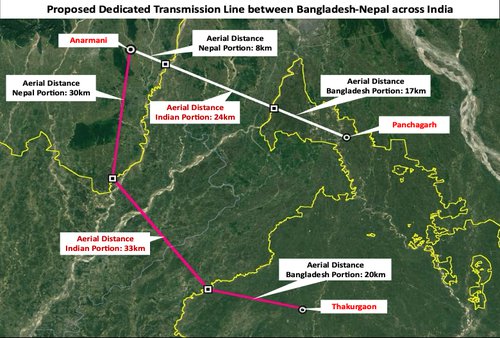
Likewise, since Nepal and India are close to agreeing on the modality for the implementation of Inaruwa (Nepal)- Purnea(New) (India) 400 kV D/c transmission line for its commissioning in the 2027/28 timeline, another long-term solution for Nepal-Bangladesh power trading could be to construct the transmission line between the sub-stations in Purnea (New) (India) and Barapukaria (Bangladesh) which is about 83 km away from Thakurgaon in terms of the aerial distance.The pictorial representation for the same can be made as follows:
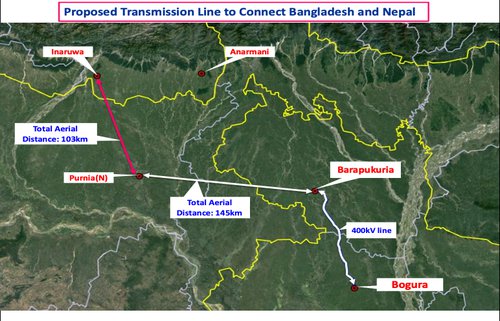
However, more can be said only after hearing India’s version whether India will be affirmative for the Purnea (New) (India) -Barapukaria (Bangladesh) 400 kV transmission line or not in the backdrop of Bornagar- Parbotipur- Katihar 765kV transmission line already planned to connect India’s Eastern and North-Eastern regions to Barapukaria/Parbotipur in Bangladesh.
Nepal’s recent policy initiatives are poised to be supportive towards the target of power import envisaged by the Bangladesh’s Master Plan. Ministry of Energy, Water Resources and Irrigation, Government of Nepal, has formulated a comprehensive, visionary plancalled “Energy Development Roadmap and Action Plan, 2023-2035” for Nepal’s power sector. It envisages the power export of 10,000 MW to India and 5,000 MW to Bangladesh by 2035. Of course, the approaches taken by both Governments of Nepal and Bangladesh are in line with emphasizing regional energy cooperation and optimum utilization of clean energy resources lying in the South Asia region. With the backdrop of accelerating concerns on climate change in line with the Paris Agreement 2015, the concept of importing electricity from the neighboring countries including Nepal and Bhutan which are rich in hydropower, while executing the Master Pan by Bangladesh, will mainly help it to meet the growing electricity demand in the following two ways:
- It will address the scenario of fuel shortage to run its own plants to some extent;
- It will maximize the utilization of lower-cost clean energies bolstering low carbonization efforts to catch up a global trend.
However, what we see as worrying is that high-capacity cross border transmission interconnections required for the huge quantum of power transaction between Bangladesh and the hydro-rich neighboring countries like Nepal and Bhutan may find geopolitical issues on the way as a major barrier to cope with since Bangladesh, Nepal and Bhutan are commonly land-bordered with India and can hence be interconnected via India only while developing cross border transmission infrastructures. Needless to say, robust transmission interconnections are the must for seamless power trading to take place among these countries.
Graduation to Higher Income Countries
Nepal aims to transform itself to a middle-income country by 2030 as the same was highlighted in the international seminar: Envisioning Nepal 2030. The report published by National Planning Commission of Nepal has pointed out that Nepal needs to introduce gradual sector reforms that include institutional efficiency enhancement through an independent regulator, separation of transmission and liberalization of distribution services, whereas cross border power trading is mentioned as the area that, inter alia, requires better infrastructure capacity and a proactive engagement in sub-regional and bilateral agreements. Of course, it will not be possible without prioritizing the power sector for enough investment.
In this regard, the opinion of Aliena B. Teplitz, the former US Ambassador to Nepal, as expressed in her article on the Kathmandu Post on November 24, 2017, seems to be relevant: “Achieving Nepal’s energy and economic goals—including becoming a middle-income nation by 2030—will require massive investments in generation, transmission, and distribution. The United States’ Millennium Challenge Corporation (MCC) has estimated that the required investment to make this dream a reality would amount to at least USD 3 billion a year.” This figure matches with the one worked out as the total fund requirement of USD 46.5 billion for the time horizon till 2035 by Ministry of Energy, Water Resources and Irrigation, Government of Nepal, while formulating the Energy Development Roadmap and Action for Nepal’s power sector. Likewise, Vision 2041 of Bangladesh Government has made the aim to reach the status of the upper middle class by 2030 and a high economic nation by 2041 and, to achieve the same, it has prioritized power and energy sector as a key booster to the economy.
40 MW Deal as a Gate Opener
After an MoU was signed on Cooperation in the Field of Power Sector between Nepal and Bangladesh on August 10, 2018, the two countries have been regularly deliberating on the power sector issues related to them. In this series, the 5th JWG/JSC meeting between Nepal and Bangladesh held on May 15-16, 2023 at Patuakhali, Bangladesh, had agreed that Tripartite Power Sales Agreement for sale of power up to 40 MW from Nepal to Bangladesh by using the Indian grid will be signed at the earliest possible after completing the administrative procedures including the finalization of the tariff. Before it, the 10th JWG/JSC Meeting between Nepal and India held on February 18, 2023 in Mount Abu, Rajasthan, India, had paved the way for the Agreement by stating that the Designated Authority of India would examine the proposal regarding the power transfer from specific generator(s) within the framework of Import/Export (Cross Border) Guidelines- 2018 of India.
When this power trading starts between Nepal and Bangladesh, it will be an inaugural version of power trading marked by a remarkable transition from bilateralism to trilateralism and its importance lies in the fact that it can be considered as a gate-opener to future deals between the two countries for any large quantum of power trading. Since the diplomatic relations in 1972, Nepal and Bangladesh have traveled a long journey in power sector cooperation to arrive at this point of power trading through the following chronological events:
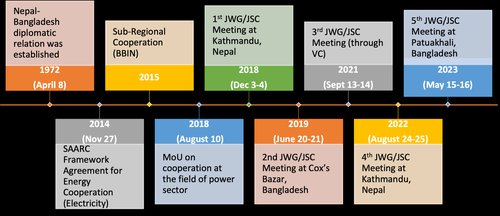
The draft Tripartite Power Sales Agreement (TPSA) had already been agreedexcept the electricity tariff and the trading margin by the three concerned entities – Nepal Electricity Authority (NEA), Bangladesh Power Development Board (BPDB) and NTPC Vidyut Vyapar Nigam (NVVN) on behalf Nepal, Bangladesh and India respectively in July 2023. After many months, Bangladesh has moved one step forward by making a decision about it according to the Bangladeshi media. The decision was reportedly made by the Cabinet Committee on Government Purchaseon June 11, 2024 to approve the proposal for importing 40 MW of hydropower from Nepal at the rate of Tk 8.17, comprising the applicable energy tariff of US Cents 4.6 per unit payable to NEA, a trading margin of INR 0.0595 per unit payable to NVVN and other non-negotiable grid-related charges.These charges include all open access and transmission charges including but not limited to applicable ISTS charges and losses, scheduling charges, operating charges of RLDC/SLDC, NOC/Settlement Nodal Agency (SNA) charges, and application charge or any other charges as may be applicable in accordance with CERC Regulations of India. Likewise, transmission losses from the delivery point of Muzaffarpur to the drawl point of Baharampur as per the CERC Regulations shall be applicable to the period of the monthly invoice.
The decision of Bangladesh Government as informed to the national media by Mahmudul Hossain Khan, the Cabinet Division (reforms and coordination) Secretary, has paved the way to sign the Agreement among the concerned entities of the three countries in near future. As per the TPSA to be signed, 40 MW of power export by Nepal onRound-the-Clock basis will take place from June 15 to November 15 every year for the period of 5 years from the date of signing the Agreement. Since the power transfer is to take place via the Indian grid, it falls within the ambit of Government of India’s Guidelines for Import/Export (Cross Border) of Electricity – 2018, the subsequent CERC Regulations 2019 and DA’s Procedure 2021. That is why the Tripartite Agreement needs to be signed by the entities of three countries. The Agreement will be matter of writing a new history between Nepal and Bangladesh because, with it, the two countries will be starting an era of power trade-based relations through Nepal’s hydropower, no matter what quantum.
After the Agreement is signed, the following steps are required to be accomplished before the commencement of the power export from Nepal to Bangladesh by using 400 kV Dhalkebar (Nepal)-Muzaffarpur (India) Cross Border Transmission Line, 400 kV Baharampur (India) - Bheramara (Bangladesh) Cross Border Transmission Line and the Indian grid between the two Substations at Muzaffarpur and Baharampur in India:
- Tripartite Agreement signing
- Submission of complete documents along with TPSA and necessary details of specific hydropower projects to NVVN
- Submission of complete application set to Designated Authority of India (Member, Power System, Central Electricity Authority, India)
- Approval from the Designated Authority of India
- Submission of the required forms and documents to Central Transmission Utility of India for grant of General Network Access
- Approval of Open Access for using the Indian grid
- Scheduling, dispatch and booking of transmission corridor, and finally
- Commencement of power supply.
Electricity Pricing
Further, market studies need to be performed to examine whether the price of electricity Bangladesh offers to Nepal is more attractive than the one we are or can be offered by the Indian entities. If Bangladesh really wants to purchase Nepal’s electricity in future, it should be willingly ready through the avoided cost principle, too, so that Nepal could feel the price agreeable to export electricity to Bangladesh.
According to Bangladesh Power Development Board (BPDB) Annual Report for the fiscal year 2022/23, the average cost of power generation per unit was Tk 8.54 in fiscal year 2021-2022 and Tk 11.02 in fiscal year 2022-2023. Likewise, as for the price of electricity in India, CERC Annual Report for the fiscal year 2022/23 has revealed that Weighted Average Price of electricity transacted through traders, Weighted Average Price of Electricity transacted through various markets of Power Exchanges and Average Price of Electricity transacted through Deviation Settlement Mechanism (DSM) were, in INR/kWh, 5.85, 6.25 and 5.39 respectively.
When Nepal plans to export more power to Bangladesh, the familiarity with such rates of electricity in addition to the assessment of generation and power purchase cost in Nepal will be useful in tariff negotiation in future. A study on Economic Benefits of Bangladesh-India Electricity Trade carried out by Integrated Research and Action for Development (IRADe) modelling the 2030 and 2045 scenario has pointed out that that power import from India is the second most economical option for meeting future demand in Bangladesh. It is advisable that Nepal conduct similar studies without ignoring the transmission service charges for associated Nepal-India cross border transmission lines with regard to Nepal-Bangladesh electricity trade to avoid tariff negotiations on an ad-hoc basis in future.
Tripartite Understanding
Having considered the deal of 40 MW of power export from Nepal to Bangladesh as a gate opener, how far we can go and succeed depends on how the trio of Nepal, India and Bangladesh will be working together and understanding one another in future. Of course, all of us need to function in line with the broader spirit of power sector cooperation. For this to happen, India’s role is crucial, critical and pivotal because neither Bangladesh nor Nepal can export or import a large quantum of power between the two if India is not willing to cooperate as India geographically lies between them and robust transmission interconnects are inevitably required in the Indian territory to be built.
This being a reality, our roles to instrumentalize various degrees of diplomacy and strategic actions are extremely important here. Building dedicated transmission systems between Nepal and Bangladesh through a tripartite understanding is always better than to rely on the use of the Indian transmission networks by paying the associated wheeling charges, operation charges and the trading margins. Unless trilateral and multilateral power trading is ensured, there is always the risk of one country’s monopoly to prevail and the concept of regional power sector cooperation will illusively end in a fiasco. Hence, the choiceless situation should not come that Nepal is bound to sell all of its surplus power to India alone at low prices and that India will be further selling the same to the third country at its own discretion regarding every matter including the price.
Geopolitics: Obstacle or Opportunity?
Of course, Nepal wishes that the development in cross border trading of power would flower out into the prosperity and poverty alleviation of South Asia in future although uncertainty looms large attributable to geopolitical issues. But let us hope that politics will no longer prevail finally over humanity which is the only truth, the only way to rid all people of distress and misery, no matter where they are born. In this spirit, our country leaders should have no less courage and the magnanimity to realize and embrace the same. They should understand that every fight or friction will weaken their internal strength alone. The spirit of solidarity, of common well-being and of becoming South Asians should touch the politicians of this region. This all, with the changing times, calls for collaboration built on the foundation of mutual trust and openness. Coming to Nepal, the root cause of our poor economic achievement is that the leaders who are and were in the hot seats of the country could not deeply perceive the importance of sustainably utilizing our principal resources - Himalayas, rivers, forests, mountains, plains and many more which many other countries don’t have.
In fact, South Asian geopolitics can be used by Nepal as an opportunity to build Nepal and bolster its economy by adhering to strategic and dialogue-based approaches, instead of reactive and reactionary steps, with our neighboring countries. Let us hope that collaboration will grow among us and we will be making the timely use of our resources to take advantage of them in national, sub- regional and regional context. The only way to meet the aspiration is to do it now by avoiding aggressive nationalism and to consider our wealth of water resources, specifically if not generally, for production of power and its equitable distribution preferably in the domestic market and alternatively in the neighboring markets. Such markets for surplus electricity we produce from our water resources may be found in India, Bangladesh and other countries, which can be reached through cross border interconnections, in the interests of the nation subject to geopolitics, grid availability and electricity pricing.
Without a disregard to energy security, let us consider electricity generation and consumption from purely a market-based perspective as a means of far-reaching economic revolution required Nepal for long. If we forget to listen to the vibes and the vibrations of a live power market, both inside and outside the country, it will repel investments from hydropower industries and the economy will ultimately start to decay leading to a continuous disconnection with the resources.
Adhikari is an Energy Expert and the former Deputy Managing Director of Nepal Electricity Authority. He can be reached at prabaladhikary@gmail.com.

Prabal Adhikari
Adhikari is an Energy Expert and the former Deputy Managing Director of Nepal Electricity Authority. He can be reached at prabaladhikary@gmail.com
- TOWARDS ENERGY & ECONOMY: Driving Nepal’s Energy Aspirations
- Jul 10, 2025
- Power Sector Uncertainties Tracking Peril And Paradoxes
- Jun 18, 2025
- FROM POLITICS TO GEOPOLITICS: The Echoes Of Electricity
- May 07, 2024
- WAKEUP CALL FOR NEPAL: Energy Security Splashing Shame On Water Resources
- Apr 03, 2024
- STRIFE IN NEPAL’S ENERGY SECTOR: Unlocking the Power of Hydropower
- Mar 28, 2024










